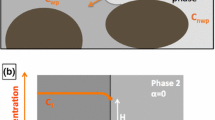Abstract
A three-dimensional, three-phase numerical model is presented for simulating the movement of immiscible fluids, including nonaqueous-phase liquids (NAPLs), through porous media. The model is designed to simulate soil flume experiments and for practical application to a wide variety of contamination scenarios involving light or dense NAPLs in heterogeneous subsurface systems. The model is derived for the three-phase flow of water, NAPL, and air in porous media. The basic governing equations are based upon the mass conservation of the constitutents within the phases. The descretization chosen to transform the governing equations into the approximating equations, although logically regular, is very general. The approximating equations are a set of simultaneous coupled nonlinear equations which are solved by the Newton-Raphson method. The linear system solutions needed for the Newton-Raphson method are obtained using a matrix of preconditioner/accelerator iterative methods.
Because of the special way the governing equations are implemented, the model is capable of simulating many of the phenomena considered necessary for the sucessful simulation of field problems including entry pressure phenomena, entrapment, and preferential flow paths. The model is verified by comparing it with several exact analytic test solutions and three soil flume experiments involving the introduction and movement of light nonaqueous-phase liquid (LNAPL) or dense nonaqueous-phase liquid (DNAPL) in heterogeneous sand containing a watertable.
Similar content being viewed by others
References
L.M. Abriola and G.F. Pinder, A multiphase approach to the modeling of porous media contamination by organic compounds, 1. Equation development, Water Resour. Res. 21(1) (1985) 11-18.
R.H. Brooks and A.T. Corey, Hydraulic properties of porous media, Colorado State University (1964).
R.E. Collins, Flow of Fluids through Porous Material(Reinhold, New York, NY, 1961).
M.Y. Corapcioglu and A. Baehr, A compositional multiphase model for groundwater contamination by petroleum products: Theoretical considerations, Water Resour. Res. 23(1) (1987) 191-200.
C.J. Van Duijn, J. Molenaar and M.J. Neef, Effects of capillary forces on immiscible two-phase flow in heterogeneous porous media, Transport in Porous Media 21 (1995) 71-93.
R.W. Falta, K. Pruess, I. Javandel and P.A. Witherspoon, Numerical modeling of steam injection for the removal of nonaqueous phase liquids from the subsurface, 1. Numerical formulation, Water Resour. Res. 28(2) (1992) 443-449.
C.R. Faust, J. Guswa and J.W. Mercer, Simulation of three-dimensional flow of immiscible fluids within and below the unsaturated zone, Water Resour. Res. 25(12) (1989) 2440-2464.
P.A. Forsyth, A control volume finite element approach to NAPL groundwater contamination, SIAM J. Sci. Statist. Comput. 12(5) (1991) 1029-1057.
P.A. Forsyth and J. Shao, Numerical simulation of gas venting for NAPL site remediation, Research Report CS-91-06, University of Waterloo, Waterloo, ON (1991).
L.S. Fung, A.D. Hiebert and L.X. Nghiem, Reservoir simulation with a control volume finite element method, SPE Reservoir Engineering (1992) 349-357.
R. Helmig, M. Emmert and H. Sheta, Modeling of multiphase flow in heterogeneous porous media and applications, in: Proc. of the 6th Int. Conf. on Computing in Civil and Building Engineering(1995).
D.P. Hochmuth and D.K. Sunada, Groundwater model for two phase immiscible flow in coarse material, Ground Water 23(5) (1985) 617-626.
P.S. Huyakorn and G.F. Pinder, New finite element technique for the solution of two-phase flow through porous media, Adv. Water Resour. 2 (1978) 285-298.
P.S. Huyakorn, S. Panday and Y.S. Wu, A three-dimensional multiphase flow model for accessing NAPL contamination in porous and fractured media, 1. Formulation, J. Contam. Hydrol. 16 (1994) 109-130.
T.H. Illangasekare, Experimental study and modeling of pollutant transport in groundwater systems, in: Proceedings of the Joint US/Israel Workshop on Groundwater Monitoring, Ministry of Environment, Haifa, Israel (1994).
T.H. Illangasekare, D.N. Yates and E.J. Armbruster, Effect of heterogenity on transport and entrapment of nonaqueous phase waste products in aquifers: an experimental study, ASCE J. Environ. Engrg. 121(8) (1995) 572-579.
T.H. Illangasekare, D. Znidarcic, G. Walser and J. Weaver, An experimental evaluation of two sharp front models for vadose-zone nonaqueous phase liquid transport, EPA Report EPA/600/R-94/197 (1994).
K. Kalurachchi and J. Parker, An efficient finite element method for multiphase flow, Water Resour. Res. 25 (1989) 43-54.
B.H. Kueper, W. Abbott and G. Farquhar, Experimental observations of multiphase flow in heterogeneous porous media, J. Contam. Hydrol. 5 (1989) 83-95.
B.H. Kueper and E.O. Frind, Two-phase flow in heterogeneous porous media, 1. Model development, Water Resour. Res. 27 (1991) 1049-1057.
B.H. Kueper and E.O. Frind, Two-phase flow in heterogeneous porous media, 2. Model application, Water Resour. Res. 27 (1991) 1058.
D.B. McWhorter and D.K. Sunada, Exact integral solutions for two-phase flow, Water Resour. Res. 26(3) (1990) 399-413.
M.J. de Neef and J. Molenaar, Analysis of DNAPL infiltration in a medium with a low-permeable lens, Computational Geosciences 1 (1997) 191-214.
S. Panday, Soil and groundwater contamination by petroleum products in frozen soils, Ph.D. dissertation, Washington State University, Pullman, WA (1989).
J.L. Ramsey Jr., Experimental investigation of dense organic contaminant transport through heterogeneous porous media, Master of Science thesis, Department of Civil Engineering, University of Colorado, Boulder, CO (1992).
H.O. Schiegg and F. Schwille, Hydrocarbons in porous media, in: Transport Processes in Porous Media(Kluwer, Boston, MA, 1991) pp. 69-202.
F. Schwille, Groundwater pollution in porous media by fluids immiscible with water, in: Quality of Groundwater(Elsevier, Amsterdam, 1981) pp. 451-463.
Author information
Authors and Affiliations
Rights and permissions
About this article
Cite this article
Kuiper, L., Illangasekare, T. Numerical simulation of NAPL flow in the subsurface. Computational Geosciences 2, 171–189 (1998). https://doi.org/10.1023/A:1011550219518
Issue Date:
DOI: https://doi.org/10.1023/A:1011550219518



